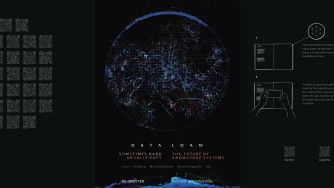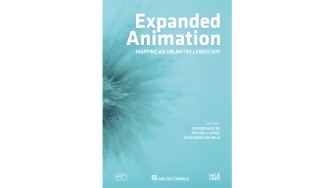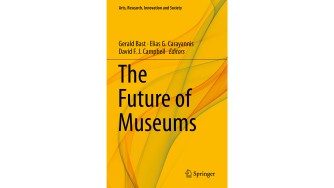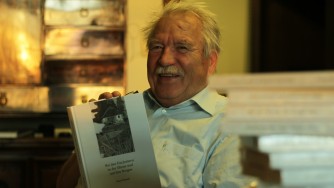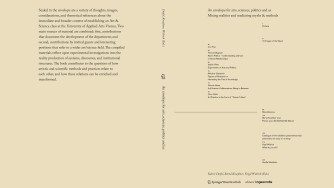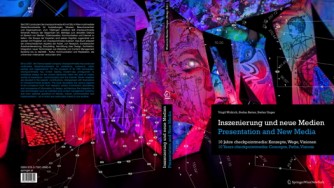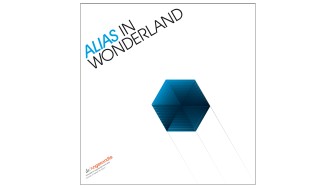Book, catalogue and print projects
Contributions, texts or catalogues and publications about or (co-)edited by Virgil Widrich. Bibliography, Publication, 2020
Hans Moser. Weltschmerzkomiker
Text contribution "Hans Moser in North Korea", Virgil Widrich in conversation with Arno Rußegger,
edited by Gottfried Schlemmer, Georg Seeßlen, Arno Rußegger. © Filmarchiv Austria, 2020.
To this day, Hans Moser is the epitome of Viennese humor and comedy that is perceived as typically Austrian. Even during his lifetime, his name became a household word and has become detached from his work. Even those who have never seen a film with him know what and who is meant when he is mentioned. Moser represents the comedic "legacy" of the First and Second Republics like no other. This book serves as a guide through the impressive oeuvre that Moser left behind. Rediscovering it today, over 50 years after his death, is like opening a treasure chest containing countless jewels. Hans Moser. Wiener Weltschmerzkomiker is nothing less than a multifaceted approach to Hans Moser as artist, icon, human being.
"Hans Moser is absolutely singular, incomparable, a solitaire in fact. A world actor!" Elfriede Jelinek
To this day, Hans Moser is the epitome of Viennese humor and comedy that is perceived as typically Austrian. Even during his lifetime, his name became a household word and has become detached from his work. Even those who have never seen a film with him know what and who is meant when he is mentioned. Moser represents the comedic "legacy" of the First and Second Republics like no other. This book serves as a guide through the impressive oeuvre that Moser left behind. Rediscovering it today, over 50 years after his death, is like opening a treasure chest containing countless jewels. Hans Moser. Wiener Weltschmerzkomiker is nothing less than a multifaceted approach to Hans Moser as artist, icon, human being.
"Hans Moser is absolutely singular, incomparable, a solitaire in fact. A world actor!" Elfriede Jelinek
Bibliography, Publication, 2020
Data Loam Sometimes Hard, Usually Soft. The Future of Knowledge Systems
Big data: A matter of art
As a reaction to the dominant effect and interpretive authority of the digital, Data Loam combines radical approaches based on positions taken in the international practice of contemporary art.
Previously: insistence on indexicality and the instrumental reduction of knowledge. Instead: a new metric that requires play, curiosity, experiment, and risk. As an urgent response to the continually growing flood of information that libraries, search engines, and cultural institutions are exposed to, the authors develop approaches that suggest and permit sensual logic, causal permeability, and new forms of man–machine interaction.
Data Loam focuses on the future of knowledge systems in texts about artificial intelligence, cybernetics, and cryptoeconomics – as a means of counteracting end-of-the-world fears.
New approaches to AI, cybernetics, and cryptoeconomics in the context of contemporary art
Alternative models of data mining, indexing, correlation
The significance of knowledge in the 21st century as an expression of sense/sensuality, experiment, risk
As a reaction to the dominant effect and interpretive authority of the digital, Data Loam combines radical approaches based on positions taken in the international practice of contemporary art.
Previously: insistence on indexicality and the instrumental reduction of knowledge. Instead: a new metric that requires play, curiosity, experiment, and risk. As an urgent response to the continually growing flood of information that libraries, search engines, and cultural institutions are exposed to, the authors develop approaches that suggest and permit sensual logic, causal permeability, and new forms of man–machine interaction.
Data Loam focuses on the future of knowledge systems in texts about artificial intelligence, cybernetics, and cryptoeconomics – as a means of counteracting end-of-the-world fears.
New approaches to AI, cybernetics, and cryptoeconomics in the context of contemporary art
Alternative models of data mining, indexing, correlation
The significance of knowledge in the 21st century as an expression of sense/sensuality, experiment, risk
Bibliography, Publication, 2019
Expanded Animation – Mapping an unlimited landscape
Text contribution
"Images between Digital Realism and Analog Believability" by Virgil Widrich in: Expanded Animation – Mapping to Unlimited
Landscape
Bibliography, Publication, 2018
The Future of Museums
Text contribution in "The Future of Museums", edided by Gerald Bast, Elias
G. Carayannis and David F. J. Campbell: "Transforming Education and Labor in a Museum as a Model of the Future: Vacancies
in the Future Museum". Published by Springer, ISBN
978-3-319-93954-4
Publication, 2018
Contribution in the March issue of the Spanish "Found Footage
Magazine" about Peter Tscherkassky.
Bibliography, Publication, 2016
Bei den Fischottern in der Ebene und auf den Bergen
In his "biographical
fragments for the home and village", Hans Widrich (born 1936) describes the landscapes of his childhood and youth as well
as exciting times as press officer to the archbishop and the Salzburg Festival.
Bibliography, Publication, 2012
Hundert Jahre Kupelwieser auf dem Mönchsberg
"Eine kleine Haus- und Familiengeschichte"
by Hans Widrich, editor: Virgil Widrich
Bibliography, Publication, 2011
An envelope for arts, sciences, politics and us
Mixing realities and mediating
myths & methods
Editors: Valerie Deifel, Bernd Kräftner, Virgil Widrich
Sealed in the book/envelope are a variety of thoughts, images, considerations, and theoretical references about the immediate and broader context of establishing an Art & Science class at the University of Applied Arts Vienna. Two main sources of material are combined: first, contributions that document the development of the department; and second, contributions by invited guests and interesting positions that refer to a wider art/science field. The compiled materials reflect upon experimental investigations into the reality of production of systems, discourses, and institutional structures. The book contributes to the questions of how artistic and scientific methods and practices relate to each other, and how these relations can be enriched and transformed.
Abstract by Valerie Deifel
Editors: Valerie Deifel, Bernd Kräftner, Virgil Widrich
Sealed in the book/envelope are a variety of thoughts, images, considerations, and theoretical references about the immediate and broader context of establishing an Art & Science class at the University of Applied Arts Vienna. Two main sources of material are combined: first, contributions that document the development of the department; and second, contributions by invited guests and interesting positions that refer to a wider art/science field. The compiled materials reflect upon experimental investigations into the reality of production of systems, discourses, and institutional structures. The book contributes to the questions of how artistic and scientific methods and practices relate to each other, and how these relations can be enriched and transformed.
Abstract by Valerie Deifel
Bibliography, Publication, checkpointmedia, 2011
Presentation and new Media – 10 Years checkpointmedia: concepts, paths, visions
Since 2001, the Vienna-based company checkpointmedia has produced multimedia Gesamtkunstwerke for exhibitions, museums, visitor
centres and organisations. Besides an overview of projects carried out over the last ten years, the book "Presentation and
New Media – 10 Years checkpointmedia: Concepts, Paths, Visions" contains essays by leading contemporary protagonists on the
current discourse in the media, worlds of experience, communication and internet sectors. Seven chapters of the book are devoted
to experts' contributions, interspersed with illustrations of checkpointmedia projects. The book elucidates the various aspects
of the company's work, from research, artistic involvement, storytelling and the provision of information on subjects such
as design, architecture and the integration of new technologies such as websites and content management systems, to the exploration
of questions of identity, culture, communication and implementation - all of which are inextricably linked to one another.
Published by Springer-Verlag Vienna/New York
Published by Springer-Verlag Vienna/New York
Bibliography, Publication, University of Applied Arts, 2009
Catalogue "Alias in Wonderland"
Exhibition of the Digital
Art Department/University of Applied Arts Vienna,
June 25th to July 12th 2009, Freiraum/quartier21, Museumsplatz 1, 1070 Wien
Text for the exhibition by Univ.-Prof. Virgil Widrich and Dipl. Ing. Arch. Nicolaj Kirisits:
The shaping of reality takes place using references and images. In the digital age, the number of images has grown exponentially. In computing, a reference point is designated as an "alias". The alias was invented in order to be able to use memory capacity in a more efficient manner. The alias is subject to size limitations, but nonetheless already provides an idea of the original to which it refers. Thus an alias in a computer is a signpost to a larger file and a reference to data that exists elsewhere. Accordingly, in other words, an alias is a type of key, or "rabbit hole" to memory.
In the economics of attentiveness, the alias can also be understood as a unit of currency. The more frequently a scientist employs quotations, an artist creates recipes or a star is commented upon, the higher the social and monetary value. At the same time, the alias constitutes a reduction of the original, whereby images are more easily scaled down than artistic formats such as theatre, performance or interactive art. Artistic formats, which cannot employ reduction as a quality, are among the losers. By contrast, there are banal interventions, the reduced images of which, attract attention and can be easily disseminated in digital forms as an alias, and thus achieve undreamt of success.
Like everything else, art is created in the mind of the recipient and therefore, even the original can be understood as a reference to the actual place where reality is created.
The concept of the "Alias in Wonderland" exhibition facilitates the simultaneous and compact representation of the diversity of both the "Digital Art" class and its work. For every "original", an alias has been created, whereby on occasion the alias can itself be the original. An area 30x30x30cm has been stipulated for the exhibits, which are contained in a mobile base. Visitors in Wonderland can move every alias and two docking stations are available for the release of classified, supplementary information and media content from the work. The originals are elsewhere.
June 25th to July 12th 2009, Freiraum/quartier21, Museumsplatz 1, 1070 Wien
Text for the exhibition by Univ.-Prof. Virgil Widrich and Dipl. Ing. Arch. Nicolaj Kirisits:
The shaping of reality takes place using references and images. In the digital age, the number of images has grown exponentially. In computing, a reference point is designated as an "alias". The alias was invented in order to be able to use memory capacity in a more efficient manner. The alias is subject to size limitations, but nonetheless already provides an idea of the original to which it refers. Thus an alias in a computer is a signpost to a larger file and a reference to data that exists elsewhere. Accordingly, in other words, an alias is a type of key, or "rabbit hole" to memory.
In the economics of attentiveness, the alias can also be understood as a unit of currency. The more frequently a scientist employs quotations, an artist creates recipes or a star is commented upon, the higher the social and monetary value. At the same time, the alias constitutes a reduction of the original, whereby images are more easily scaled down than artistic formats such as theatre, performance or interactive art. Artistic formats, which cannot employ reduction as a quality, are among the losers. By contrast, there are banal interventions, the reduced images of which, attract attention and can be easily disseminated in digital forms as an alias, and thus achieve undreamt of success.
Like everything else, art is created in the mind of the recipient and therefore, even the original can be understood as a reference to the actual place where reality is created.
The concept of the "Alias in Wonderland" exhibition facilitates the simultaneous and compact representation of the diversity of both the "Digital Art" class and its work. For every "original", an alias has been created, whereby on occasion the alias can itself be the original. An area 30x30x30cm has been stipulated for the exhibits, which are contained in a mobile base. Visitors in Wonderland can move every alias and two docking stations are available for the release of classified, supplementary information and media content from the work. The originals are elsewhere.


